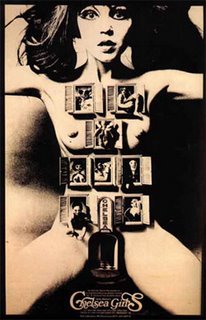Chelsea Girls
 Went with a buddy to the local screening of Warhol's 'Chelsea Girls'. Nico was...angellic. The ex-Catholic Priest confessor? Spot on. Much of the rest descended into cat fights on hotel beds and endless bitch fests. Not that there's anything wrong with catfights.
Went with a buddy to the local screening of Warhol's 'Chelsea Girls'. Nico was...angellic. The ex-Catholic Priest confessor? Spot on. Much of the rest descended into cat fights on hotel beds and endless bitch fests. Not that there's anything wrong with catfights.Felt 'sorry' for the bitches and bastards who took in the whole 3 1/2 hours. Still, some good candid stuff. Well worth it and I experienced a new projection technique unbeknownst to me.
Warhol set up the projection of two 16mm projectors side by side to create a 'split' widescreen effect. Especially like the honour it gives to the projectionist(s). Good show that must be seen with an audience and a big, wide screen.



6 Comments:
I just saw the Andy Warhol: Supernova show at the AGO this weekend, which includes looped screenings of Empire, Blow Job, Screen Tests, Couch, Kiss, and Haircut # 3
The show is curated by David Cronenburg, who narrates the gallery tour (if you get one of those listening device things) with great insight, backed with interviews from Warhol's subjects and contemporaries.
I've always enjoyed Warhol's silkscreens, but had dismissed his films as detached, alienated bullshit. I left the show with a greater understanding and respect for his filmwork - it took me 20 years to realize that was the whole point.
P.S. - I'm moving back to Blogger because I miss you. :-)
Missed you too, Cobie. I get comments, therefore I blog.
Watching the Chelsea Girls footage was very refreshing for me nowadays where high production values, and paced, polished scripts seem to detach the viewer from the filmed content.
Funny how you and I can agree with the value of Warhol's films for opposite reasons and both be right. Movie magic has killed the movies for me. The harsh lighting and poor sound made Chelsea Girls all so real to me. I felt I was in the room with the people.
Conventional wisdom says, film or television must be produced at an acceptable level of quality in order to get distribution. Nowadays alternative venues can be arranged - sides of buildings at night, for example.
Warhol, like all true independent filmmakers, was essentially someone with an idea, a camera, cheap lights and sound, and interesting people to play out parts.
Thank you for your lovely comment, Cobie. Now...I wonder what's going on over at katrocket?
Cobie, I think I get your meaning now as I think about your words and remember the film experience.
There seemed to be a terrible loneliness in the people onscreen. For a long scene two women sit on a bed with two guys. The camera focuses on the reaction of one woman as she listens to the others. She's just there, not engaged but merely present.
The sadest character (X) starts her journey through the film with an interrogation by a manipulative 'ex-Catholic Priest' who tears the poor woman to pieces on camera.
X enters the next scene, taking refuge with a deeply disturbed, sadistic woman who injects X with enough drugs to either OD or be a vegetable for weeks - for real.
From what I saw of the rest of Chelsea Girls, X lay curled up on the floor under a desk or was ordered about with shouts from other women she stayed with. Maybe someone could foist a fairytale frame on X's travels through Chelsea, but I can only read it as a sad, dark tale of our urban times.
Hope I've understood what you meant by Warhol's detached alienation.
Yes - of course we have a mutual understanding here. I haven't seen Chelsea Girls, but what you've described seems to echo the mood and intent of Warhol's other films that I mentioned. Most of them are voyeuristic to the point of extreme discomfort. The subjects stare right back at you, but they know they have a camera on them and they know we are watching. It's equally unsettling to both subject and viewer. And it's hard to look away... just as hard as it is to watch.
The exhibition focuses on Warhol's work from 1962-64, when he opened up the Factory and became obsessed with fame, celebrity, and the events that made people known to others, be it a car accident, tuna can botulism, or a popular Hollywood movie. I used to beleive that Warhol just used tragic scenes for shock value, but that was naive. It was much more about the transcendence from anonimity to fame.
What I meant by my comment is that I had never considered each graphic image as a part of a whole. I was merely viewing his work at face value - lo-fi boredom from disaffected junkies. In my arrogant youth, I didn't bother to seek out any further subtext. I dismissed his films as experiments for the sake of eccentricity. Now, twenty years later, living in our media-obsessed world, it is so easy to believe in mass recognition as a form of power, influence, and immortality.
We should go for a beer soon.
Yeah....
Good words. Interesting thoughts. Yes on the beer.
There was a PBS documentary on Warhol recently - I agree with Katrocket - his silkscreens were amazing - as a palette for his use of colours no sane person would ever use, but somehow he made work (beautifully).
Post a Comment
<< Home